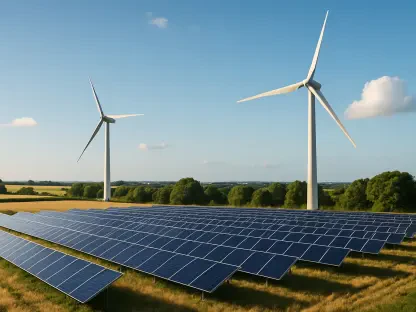In an era where energy demands are skyrocketing and the stability of global supply chains hangs in a precarious balance, the U.S. energy storage sector finds itself at a critical crossroads, compelled to adapt to both domestic and international pressures. Aging grid infrastructure groans under the weight of extreme weather and the integration of renewable sources, while geopolitical tensions and trade uncertainties threaten the steady flow of vital battery materials. Amid this complex backdrop, two transformative strategies are emerging as cornerstones for a more secure energy future: reshoring battery manufacturing to American soil and diversifying the technologies that power storage systems. These approaches promise not only to bolster national energy security but also to address the multifaceted challenges of grid reliability and sustainability. This exploration delves into how these dual pillars are reshaping the landscape, offering a pathway to resilience in an increasingly unpredictable world.
Revitalizing Domestic Production: The Reshoring Movement
The push to bring battery manufacturing back to the U.S. is gaining momentum as a direct response to escalating tariffs and export restrictions from key suppliers like China, which have disrupted traditional supply chains. Reshoring, alongside onshoring for domestic production and nearshoring with neighboring countries, aims to minimize reliance on volatile international markets. This strategic pivot is already showing progress, with companies transitioning from importing fully assembled battery packs to constructing modules locally. The long-term vision extends even further, targeting the production of battery cells and the sourcing of raw materials within U.S. borders. Such a shift is essential to shield the industry from global trade shocks and to ensure a steadier supply of critical components, ultimately fostering a more self-reliant energy storage ecosystem that can withstand external pressures and support national energy goals.
While the concept of reshoring holds immense promise, the road to implementation is fraught with financial and logistical hurdles that demand innovative solutions. Constructing a single lithium cell manufacturing facility, for instance, can require an investment exceeding half a billion dollars, a figure that poses a significant barrier for many industry players. To navigate this, larger manufacturers are forging partnerships with established battery producers that already have a foothold in the U.S., leveraging existing infrastructure to offset costs. Meanwhile, smaller firms are finding strength in numbers through joint ventures, mergers, and other collaborative models that pool resources and expertise. These cooperative efforts are demonstrating that a domestic supply chain is not merely an ambitious dream but a tangible reality taking shape, paving the way for a more robust and independent energy storage sector capable of meeting growing demands.
Addressing Grid Challenges: The Call for Modern Storage Solutions
The U.S. electrical grid is grappling with unprecedented strain, burdened by outdated infrastructure that struggles to cope with the dual challenges of extreme weather events and the rapid adoption of renewable energy sources like solar and wind. Brownouts and blackouts have become more frequent, exposing vulnerabilities that threaten both economic stability and public safety. Energy storage systems are increasingly seen as a vital remedy, offering the ability to provide backup power during outages and to smooth out the fluctuations inherent in intermittent renewables. This role elevates storage from a supplementary technology to a fundamental component of grid reliability, ensuring that clean energy can be effectively integrated without compromising the consistency of power delivery. The urgency to modernize the grid underscores the need for advanced storage solutions tailored to these evolving demands.
Beyond merely addressing immediate outages, energy storage plays a pivotal role in enabling a broader transition to a sustainable energy framework that prioritizes environmental responsibility. As the grid incorporates more renewable sources, the inconsistency of generation—such as solar power dropping off at night or wind energy varying with weather—creates a pressing need for systems that can store excess energy and release it when required. This capability not only stabilizes the grid but also reduces dependence on fossil fuel-based backup systems, aligning with national goals for carbon reduction. The challenge lies in deploying storage at a scale and efficiency that can keep pace with the accelerating shift to renewables, while also ensuring that these systems are resilient against the physical and climatic stresses that increasingly test grid infrastructure. Energy storage, therefore, emerges as a linchpin in the quest for a modern, dependable, and green energy landscape.
Breaking the Lithium Mold: Embracing Technological Variety
Lithium-based batteries, while currently dominant in the energy storage market, carry inherent risks due to their dependence on foreign supply chains that are susceptible to geopolitical disruptions and trade barriers. This over-reliance on a single chemistry is increasingly viewed as a liability, especially as the grid’s needs diversify across short-term, medium-term, and long-duration applications. Jeremy Furr, Senior Vice President at Stryten Energy, champions a shift toward a more varied technological portfolio, arguing that a mix of battery types is essential to mitigate risks and enhance adaptability. Such diversification ensures that the energy storage sector can address a spectrum of grid requirements without being hamstrung by the limitations or vulnerabilities of any one system, fostering a more flexible and secure energy infrastructure.
Diversifying beyond lithium also opens the door to leveraging the unique strengths of alternative technologies that can complement existing systems and fill critical gaps in grid functionality. A broader approach reduces exposure to supply chain bottlenecks, particularly for materials sourced from unstable regions, and allows for tailored solutions that match specific energy demands. For instance, while lithium excels in compact, high-density applications, it may not always be the most cost-effective or sustainable choice for larger-scale or longer-duration needs. By exploring and integrating other chemistries, the industry can build a more resilient framework that withstands market fluctuations and geopolitical tensions. This strategic pivot toward variety not only safeguards national energy security but also spurs innovation, encouraging the development of next-generation technologies that can further enhance grid performance and sustainability.
Alternative Powerhouses: Vanadium and Lead in the Spotlight
Among the promising alternatives to lithium, vanadium redox flow batteries (VRFBs) stand out for their suitability in long-duration energy storage, making them ideal for applications like renewable energy projects and data centers that require sustained power delivery. VRFBs benefit from a growing domestic supply chain, which reduces the risks associated with international dependencies and positions them as a viable option for scaling up grid storage. Their ability to maintain capacity over extended cycles without significant degradation adds to their appeal, offering a reliable solution for stabilizing renewable energy output over hours or even days. As the U.S. seeks to bolster its energy independence, the development and adoption of VRFBs represent a forward-thinking approach to meeting the complex demands of a modern grid while minimizing exposure to global supply chain volatilities.
In parallel, advanced lead battery energy storage systems (BESS) are carving out a significant niche in medium-duration and decentralized applications, providing a cost-effective and sustainable alternative with unique advantages. Lead BESS boast high discharge capabilities and an impressive recycling rate of nearly 100% within the U.S., aligning with environmental goals and reducing waste. A notable real-world application is the installation at Georgia Tech’s Carbon Neutral Energy Solutions Laboratory, where a lead BESS was selected for its proven reliability and eco-friendly attributes. This deployment serves as a model for how lead-based systems can support research and practical energy solutions in settings that demand consistent performance over moderate timeframes. The maturity of the domestic supply chain for lead batteries further enhances their viability, offering a ready-to-scale option for grid operators seeking dependable storage without the complexities of international sourcing.
Crafting a Resilient Energy Future: Dual Strategies at Work
The path to a secure energy future rests on the synergy between reshoring battery production and embracing a diverse array of storage technologies, each addressing distinct facets of the grid’s challenges. Strategic localization of manufacturing mitigates the risks posed by global trade uncertainties, ensuring a steady supply of critical components through domestic and regional networks. Simultaneously, a varied technological portfolio—spanning lithium, vanadium, and lead systems—equips the industry to meet the grid’s wide-ranging needs, from rapid response to prolonged storage. This dual approach not only strengthens national energy security but also positions storage as a foundational element of policy aimed at sustainable growth, reducing reliance on fossil fuels and enhancing grid stability in the face of environmental and economic shifts.
Reflecting on the strides made, it’s evident that the energy storage sector has taken decisive steps to confront supply chain vulnerabilities and grid inadequacies through calculated investments in domestic capabilities and alternative technologies. Collaborations among manufacturers have paved the way for cost-effective reshoring, while the integration of varied battery chemistries like VRFBs and lead BESS has addressed specific operational gaps. Looking ahead, the focus must shift to scaling these initiatives, with policymakers and industry leaders prioritizing incentives for local production and research into emerging storage solutions. Continued emphasis on partnerships and innovation will be crucial to fortify the grid against future disruptions, ensuring that energy storage remains a bedrock of resilience and sustainability for years to come.









